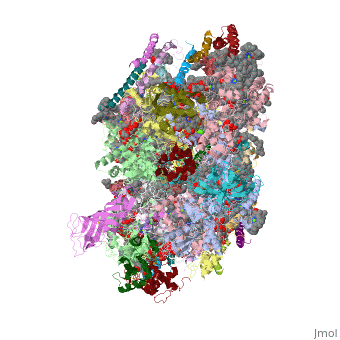3a0b
From Proteopedia
(Difference between revisions)
| Line 3: | Line 3: | ||
== Structural highlights == | == Structural highlights == | ||
<table><tr><td colspan='2'>[[3a0b]] is a 40 chain structure with sequence from [http://en.wikipedia.org/wiki/Thermosynechococcus_vulcanus Thermosynechococcus vulcanus]. Full crystallographic information is available from [http://oca.weizmann.ac.il/oca-bin/ocashort?id=3A0B OCA]. For a <b>guided tour on the structure components</b> use [http://oca.weizmann.ac.il/oca-docs/fgij/fg.htm?mol=3A0B FirstGlance]. <br> | <table><tr><td colspan='2'>[[3a0b]] is a 40 chain structure with sequence from [http://en.wikipedia.org/wiki/Thermosynechococcus_vulcanus Thermosynechococcus vulcanus]. Full crystallographic information is available from [http://oca.weizmann.ac.il/oca-bin/ocashort?id=3A0B OCA]. For a <b>guided tour on the structure components</b> use [http://oca.weizmann.ac.il/oca-docs/fgij/fg.htm?mol=3A0B FirstGlance]. <br> | ||
| - | </td></tr><tr><td class="sblockLbl"><b>[[Ligand|Ligands:]]</b></td><td class="sblockDat"><scene name='pdbligand=BCR:BETA-CAROTENE'>BCR</scene>, <scene name='pdbligand=BR:BROMIDE+ION'>BR</scene>, <scene name='pdbligand=CLA:CHLOROPHYLL+A'>CLA</scene>, <scene name='pdbligand=DGD:DIGALACTOSYL+DIACYL+GLYCEROL+(DGDG)'>DGD</scene>, <scene name='pdbligand=FE2:FE+(II)+ION'>FE2</scene>, <scene name='pdbligand=HEM:PROTOPORPHYRIN+IX+CONTAINING+FE'>HEM</scene>, <scene name='pdbligand=LHG:1,2-DIPALMITOYL-PHOSPHATIDYL-GLYCEROLE'>LHG</scene>, <scene name='pdbligand=MGE:(1S)-2-(ALPHA-L-ALLOPYRANOSYLOXY)-1-[(TRIDECANOYLOXY)METHYL]ETHYL+PALMITATE'>MGE</scene>, <scene name='pdbligand=OEC:OXYGEN+EVOLVING+SYSTEM'>OEC</scene>, <scene name='pdbligand=PHO:PHEOPHYTIN+A'>PHO</scene>, <scene name='pdbligand=PQ9:5-[(2E,6E,10E,14E,18E,22E)-3,7,11,15,19,23,27-HEPTAMETHYLOCTACOSA-2,6,10,14,18,22,26-HEPTAENYL]-2,3-DIMETHYLBENZO-1,4-QUINONE'>PQ9</scene>< | + | </td></tr><tr id='ligand'><td class="sblockLbl"><b>[[Ligand|Ligands:]]</b></td><td class="sblockDat"><scene name='pdbligand=BCR:BETA-CAROTENE'>BCR</scene>, <scene name='pdbligand=BR:BROMIDE+ION'>BR</scene>, <scene name='pdbligand=CLA:CHLOROPHYLL+A'>CLA</scene>, <scene name='pdbligand=DGD:DIGALACTOSYL+DIACYL+GLYCEROL+(DGDG)'>DGD</scene>, <scene name='pdbligand=FE2:FE+(II)+ION'>FE2</scene>, <scene name='pdbligand=HEM:PROTOPORPHYRIN+IX+CONTAINING+FE'>HEM</scene>, <scene name='pdbligand=LHG:1,2-DIPALMITOYL-PHOSPHATIDYL-GLYCEROLE'>LHG</scene>, <scene name='pdbligand=MGE:(1S)-2-(ALPHA-L-ALLOPYRANOSYLOXY)-1-[(TRIDECANOYLOXY)METHYL]ETHYL+PALMITATE'>MGE</scene>, <scene name='pdbligand=OEC:OXYGEN+EVOLVING+SYSTEM'>OEC</scene>, <scene name='pdbligand=PHO:PHEOPHYTIN+A'>PHO</scene>, <scene name='pdbligand=PQ9:5-[(2E,6E,10E,14E,18E,22E)-3,7,11,15,19,23,27-HEPTAMETHYLOCTACOSA-2,6,10,14,18,22,26-HEPTAENYL]-2,3-DIMETHYLBENZO-1,4-QUINONE'>PQ9</scene></td></tr> |
| - | <tr><td class="sblockLbl"><b>[[Non-Standard_Residue|NonStd Res:]]</b></td><td class="sblockDat"><scene name='pdbligand=UNK:UNKNOWN'>UNK</scene></td></tr> | + | <tr id='NonStdRes'><td class="sblockLbl"><b>[[Non-Standard_Residue|NonStd Res:]]</b></td><td class="sblockDat"><scene name='pdbligand=UNK:UNKNOWN'>UNK</scene></td></tr> |
| - | <tr><td class="sblockLbl"><b>[[Related_structure|Related:]]</b></td><td class="sblockDat">[[3a0h|3a0h]]</td></tr> | + | <tr id='related'><td class="sblockLbl"><b>[[Related_structure|Related:]]</b></td><td class="sblockDat">[[3a0h|3a0h]]</td></tr> |
| - | <tr><td class="sblockLbl"><b>Resources:</b></td><td class="sblockDat"><span class='plainlinks'>[http://oca.weizmann.ac.il/oca-docs/fgij/fg.htm?mol=3a0b FirstGlance], [http://oca.weizmann.ac.il/oca-bin/ocaids?id=3a0b OCA], [http://www.rcsb.org/pdb/explore.do?structureId=3a0b RCSB], [http://www.ebi.ac.uk/pdbsum/3a0b PDBsum]</span></td></tr> | + | <tr id='resources'><td class="sblockLbl"><b>Resources:</b></td><td class="sblockDat"><span class='plainlinks'>[http://oca.weizmann.ac.il/oca-docs/fgij/fg.htm?mol=3a0b FirstGlance], [http://oca.weizmann.ac.il/oca-bin/ocaids?id=3a0b OCA], [http://www.rcsb.org/pdb/explore.do?structureId=3a0b RCSB], [http://www.ebi.ac.uk/pdbsum/3a0b PDBsum]</span></td></tr> |
| - | <table> | + | </table> |
| + | == Function == | ||
| + | [[http://www.uniprot.org/uniprot/PSBF_THEVL PSBF_THEVL]] This b-type cytochrome is tightly associated with the reaction center of photosystem II (PSII). PSII is a light-driven water plastoquinone oxidoreductase, using light energy to abstract electrons from H(2)O, generating a proton gradient subsequently used for ATP formation.[HAMAP-Rule:MF_00643] [[http://www.uniprot.org/uniprot/PSBL_THEVL PSBL_THEVL]] This protein is a component of the reaction center of photosystem II (PSII). PSII is a light-driven water plastoquinone oxidoreductase, using light energy to abstract electrons from H(2)O, generating a proton gradient subsequently used for ATP formation.[HAMAP-Rule:MF_01317] [[http://www.uniprot.org/uniprot/PSBJ_THEVL PSBJ_THEVL]] This protein is a component of the reaction center of photosystem II (PSII). PSII is a light-driven water plastoquinone oxidoreductase, using light energy to abstract electrons from H(2)O, generating a proton gradient subsequently used for ATP formation.[HAMAP-Rule:MF_01305] [[http://www.uniprot.org/uniprot/PSBT_THEVL PSBT_THEVL]] Seems to play a role in the dimerization of photosystem II (PSII). PSII is a light-driven water plastoquinone oxidoreductase, using light energy to abstract electrons from H(2)O, generating a proton gradient subsequently used for ATP formation.[HAMAP-Rule:MF_00808] [[http://www.uniprot.org/uniprot/PSBA_THEVL PSBA_THEVL]] D1 (PsbA) and D2 (PsbD) bind P680, the primary electron donor of photosystem II (PSII) as well as electron acceptors. PSII is a light-driven water plastoquinone oxidoreductase, using light energy to abstract electrons from H(2)O, generating a proton gradient subsequently used for ATP formation.[HAMAP-Rule:MF_01379] [[http://www.uniprot.org/uniprot/CY550_THEVL CY550_THEVL]] Low-potential cytochrome c that plays a role in the oxygen-evolving complex of photosystem II (PSII). Binds to PSII in the absence of other extrinsic proteins; required for binding of the PsbU protein to photosystem II. In PSII particles without oxygen-evolving activity, maximal activity is restored only by binding of cytochrome c550, PsbU and the 33 kDa PsbO protein. PSII is a light-driven water plastoquinone oxidoreductase, using light energy to abstract electrons from H(2)O, generating a proton gradient subsequently used for ATP formation.<ref>PMID:1314738</ref> <ref>PMID:8382523</ref> [[http://www.uniprot.org/uniprot/PSBE_THEVL PSBE_THEVL]] This b-type cytochrome is tightly associated with the reaction center of photosystem II (PSII). PSII is a light-driven water plastoquinone oxidoreductase, using light energy to abstract electrons from H(2)O, generating a proton gradient subsequently used for ATP formation.[HAMAP-Rule:MF_00642] | ||
== Evolutionary Conservation == | == Evolutionary Conservation == | ||
[[Image:Consurf_key_small.gif|200px|right]] | [[Image:Consurf_key_small.gif|200px|right]] | ||
| Line 35: | Line 37: | ||
</StructureSection> | </StructureSection> | ||
[[Category: Thermosynechococcus vulcanus]] | [[Category: Thermosynechococcus vulcanus]] | ||
| - | [[Category: Kamiya, N | + | [[Category: Kamiya, N]] |
| - | [[Category: Kawakami, K | + | [[Category: Kawakami, K]] |
| - | [[Category: Shen, J R | + | [[Category: Shen, J R]] |
| - | [[Category: Umena, Y | + | [[Category: Umena, Y]] |
[[Category: Electron transport]] | [[Category: Electron transport]] | ||
[[Category: Heme]] | [[Category: Heme]] | ||
Revision as of 22:12, 25 December 2014
Crystal structure of Br-substituted Photosystem II complex
| |||||||||||


